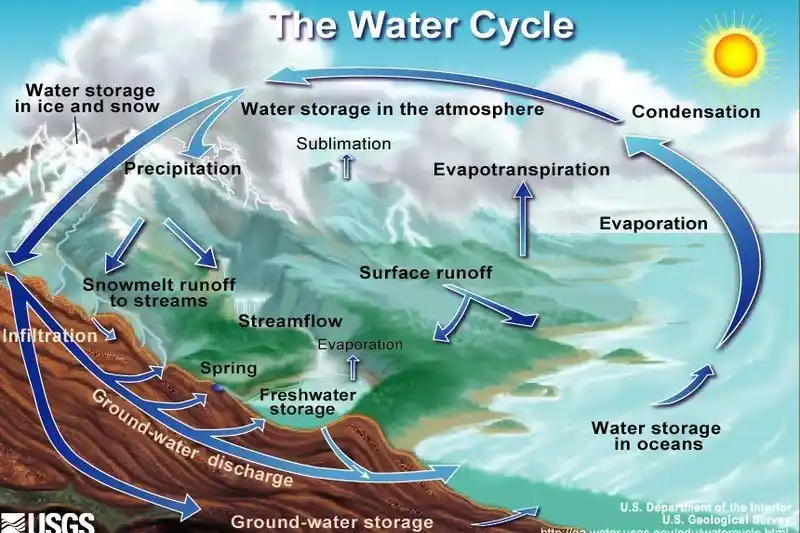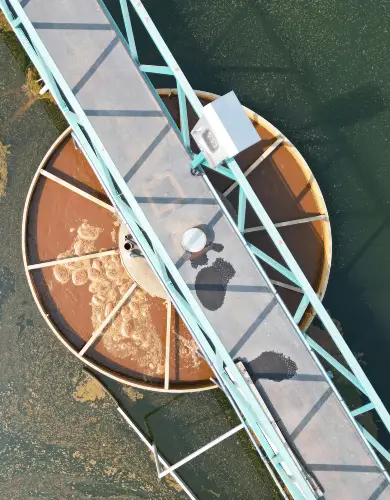Understanding the water cycle
The water cycle describes the continuous movement of water as it evaporates from the Earth’s surface, forms clouds, precipitates back to the ground and flows through our rivers, lakes, and oceans.
This natural cycle is not just a series of steps that water undergoes – it’s a lifeline for ecosystems across the globe, providing essential hydration to plants and animals.
For humans, the water cycle dictates the availability of freshwater needed for drinking, agriculture and many other aspects of day-to-day life.
Water scarcity is a growing problem in the UK. In this article, we’ll explain the importance of the water cycle on British water infrastructure and the growing challenges presented by climate change.
What is the water cycle?
The water cycle is a continuous process whereby fresh water is transferred from the ocean to the land via the atmosphere.

The water cycle comprises the following processes that transform and move water from one state to another:
Evaporation
The sun shines on the ocean, transferring solar energy to the surface water. Solar energy causes evaporation, where water molecules in the sea turn from a liquid into a gas in the air.
Condensation
The evaporated water rises through the atmosphere, gradually cooling. Once sufficiently cooled, the individual molecules condense to form water droplets. A vast number of individual water droplets form clouds.
Precipitation
Water droplets in clouds gradually merge, forming larger and larger droplets. Larger droplets are heavier and, at a certain point, will fall from the cloud as rain or snow.
Runoff
Rain falling on the land will flow, either above or below ground, into streams and rivers. The streams and rivers fill the artificial reservoirs that supply the mains network. Eventually, the water from streams, rivers and reservoirs will flow back into the sea, completing the water cycle.
Why is the water cycle important for water supplies?
The British Water network provides a reliable supply of some of the highest quality drinking water in the world.
This water supplies used by British businesses and homes and is first extracted from the following freshwater sources by local water companies:
- Rivers
- Lakes
- Underground reservoirs (Aquifiers)
The extracted water is temporarily stored in manmade reservoirs prior to treatment.
💡Using water from the sea is possible using a process called desalination. Desalination is very energy intensive, so it is not a sustainable water source and is incredibly expensive at current business electricity prices.
Britain’s water companies rely on the water cycle to replenish the rivers and aquifers for sufficient water to meet demand.
The impact on the water cycle from climate change
Climate change is impacting the water cycle and is increasing instances of extreme weather across the globe.
Rising temperatures affect the water cycle, causing a measurable increase in the frequency of droughts and floods in the UK. Here, we’ll explain both:
Increased flooding risk
Increases in the average temperatures in the UK have the following cascading effect on the water cycle:
- Increased evaporation: As temperatures rise, the evaporation rate from the Earth’s surface into the atmosphere increases.
- Increased atmospheric moisture rates: A warmer atmosphere can hold more moisture. For every 1°C rise in temperature, the atmosphere’s capacity to hold water vapour increases by approximately 7%.
- Increased intensity of rain: The additional moisture in the atmosphere caused by the two effects above results in more intense rainfall.
- Saturated soil and reduced infiltration: As the intensity of rain increases, the soil becomes more saturated, reducing its ability to absorb water. This leads to more runoff into rivers and lakes, raising the likelihood of flooding.
Increased water scarcity
Rising temperatures in the UK are making fresh water sources less reliable and more difficult for British water companies to store.
Water stored in the soil will evaporate back into the atmosphere at higher temperatures instead of flowing into streams and rivers. Less water in rivers means less water available to fill the man-made reservoirs the British water infrastructure uses.
Additionally, at these higher temperatures, more fresh water is lost directly to reservoir evaporation during storage.
How the UK water industry is responding to climate change?
The UK water industry is set to invest £96 billion in infrastructure improvements between 2025 and 2030, with a large part of the investment tackling water scarcity and flooding.
What is the UK water industry doing about water scarcity?
The impact of climate change is increasing water scarcity in South East England, particularly impacting the Thames Water, Affinity Water, SES and Southern Water networks.
In response to these challenges, these water companies are:
- Identifying and fixing water leaks on the potable water network using drones, satellites and acoustic loggers
- Planning the building of new reservoirs and expanding existing reservoirs to allow increased capacity during droughts.
- Mandating a roll-out of water meters to homes and businesses in the worst impacted areas to improve the data on where water is used the most.
- Identifying gap sites properties that use water but have not been recorded as supply points on the water network.
- Increasing water transfer infrastructure to allow water companies to move water long distances from areas of lower water scarcity during droughts.
What is the UK water industry doing about increased flooding?
The water companies in Britain are responsible for surface water drainage to ensure that rain falling on towns and cities is quickly directed into a series of pipes that lead to the nearest rivers.
The increased heavy rainfall caused by climate change often overwhelms these drainage systems, resulting in flooding.
The water industry uses storm overflows to divert water during intense rain. Water companies are investing in improving the capacity of storm overflows.
Older storm overflows use a single pipe to carry both sewage and rainfall, which can result in raw sewage being dumped into rivers and seas. Water companies are investing in eliminating or improving these older storm overflows.
Why should businesses be concerned about water scarcity and the efficiency of their water use?
Most businesses rely on a freshwater supply. Even a small shop needs a flushing toilet and somewhere for employees to wash their hands.
Businesses can and should do their part to ensure the sustainability of the British Water network as part of their corporate social responsibility strategy.
But there is another, more direct reason for businesses. Most companies in the UK have a water meter, so they are charged business water rates on a volumetric basis for each cubic meter they consume.
Taking small steps to reduce their water consumption results in cheaper business water bills.
How can my business be more sustainable?
Businesses across the UK are seeking to reduce their carbon emissions, and evaluating the environmental impact of water supplies is an important component of improving corporate sustainability.
For most businesses, there is no alternative to using the water supply services offered by your local water company. A borehole water supply offers one exception, but it is only suitable in certain circumstances.
In the deregulated water market, companies can choose their business water supplier. Some suppliers are now offering sustainable business water solutions such as:
- Helping businesses reduce wasted water consumption by installing simple water-saving devices.
- Offering green water tariffs that offset the carbon emissions associated with water supply.
At AquaSwitch, we can help you switch business water to a sustainable business water supply with our business water comparison service.
💡The water industry uses consumes huge amounts of electricity in pumping water. Water companies are increasingly looking to produce renewable sources of business energy to power the water grid.
Find the green energy tariffs available to your business with our business energy comparison service.

